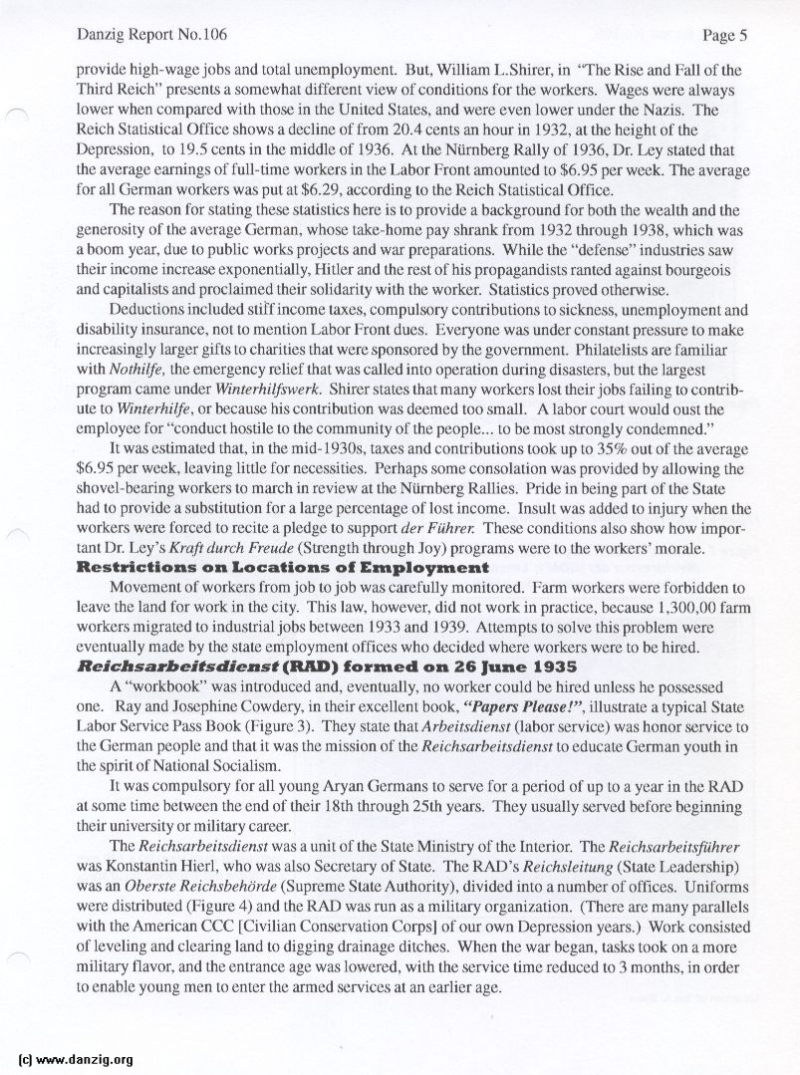
> Conditions in Nazi Germany during the 1930s
provide high-wage jobs and total unemployment. Hut. William LShircr, in the Rise and Fall of the Third Reich” presents a somewhat different view of conditions for the workers. Wages were always lower when compared with those in the United States, and were even lower under the Nazis. The Reich Statistical Office shows a decline of from 20.4 cents an hour in 1932. at the height of the 1)cpression. to 19.5 cents in the middle of 1936. At the Nürnborg Rally of 1936, 1)r. Ley stated that the average earnings of full-time workers in (he I ahor Front amounted to $6.95 per week. The average for all German workers was put at $6.29. according to the Reich Statistical Office.
The reason for stating these statistics here is to provide a background for both the wealth and the generosity of the average German, whose take-home pay shrank from 1932 through 1938, which was a boom year. due to public works projects and war preparations. While the “delinse” industries saw their income increase exponentially, Hitler and the rest of his propagandists ranted against bourgeois and capitalists and proclaimed their solidarity with the worker. Statistics proved otherwise.
Deductions included stiff income taxes, compulsory contributions to sickness, unemployment and disability insurance, not to mention Labor front dues. Everyone was under constant pressure to make increasingly larger gins to charities that wre sponsored by the government. Philawlists are familiar with Noihilfe, the emergency relief that was called into operation during disasters, hut the largest program came under Winxerhil,frverk. Shircr states that many workers lost their jobs failing to contribu te to Winferhilfe, or because his contribution wa.s deemed too small. A labor CoUrt would oust the employee for “conduct hostile to the community of the people... to be most strongly condemned.”
It was estimated that, in the rnid-1930s, taxes and contributions took up to 35% out of the average $6.95 per week, leaving little for necessities. Perhaps some consolation was provided by allowing the shovel-bearing workers to march in review at the Nürnberg Rallies. Pride in being part of the State had to provide a substitution for a large percentage of lost income. Insult was added to injury when the workers were forced to recite a pledge to support der Führrr These conditions also show how import ant I)r. Ley’s Km/i durch Freude (Strength through Joy) programs were to the workers’ morale.
Restrictions on Locations of Employment
Movement of workers from job to job was carefully monitored. Farm workers were forbidden to leave the land for work in the city. This law, however, did not work in practice, because 1.300,00 farm workers migrated to industrial jobs between 1933 and 1939. Attemplsto solve this problem were eventually made by the state employment offices who decided where workers were to he hired.
Reichsarbeitsdienst (RAD) formed on 26 June 1935
A “workbook” was introduced and, eventually, no worker could be hired unless he possessed one. Ray and Josephine Cowdcry, in their excellent hook, “Papers Please!”, illustrate a typical State labor Service Pass Hook (Figure 3). They state that Arheiisdienst (labor service) was honor service to the German people and that it was the mission ot the Re’ichscrheirsiiensi to educate German youth in the spirit of National Socialism.
It was compulsory for all young Aryan Germans to serve for a period of up to a year in the RAI) at sortie time between the end of their 18th through 25th years. They usually served before beginning their university or military career.
The Reichsurheitsdiensi was a unit of the State Ministry of the Interior. The Reichsarbeitfuhrer was Konstantin Hierl, who was also Secretary of State. The RAI)’s Reichsleitung (State Leadership) was an Oberste Reichsbehörde (Supreme State Authority), divided into a number of offices. Uniforms were distributed (Figure 4) and the kAl) was run as a military organization. (There arc many parallels with the American CCC (Civilian Conservation Corps) of our Of our depressionsion years, Work consisted of leveling and clearing land to digging drainage ditches. When the war began, tasks took on a more military flavor, and the entrance age was lowered, with the service time reduced to 3 months, in order to enable young men to enter the armed services at an earlier age.
Danzig Report Nr. 106 - January - February - March - 2000, Page 5.
Hits: 3950
Added: 26/07/2015
Copyright: 2025 Danzig.org

